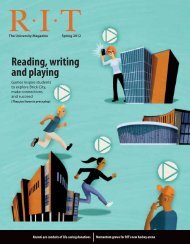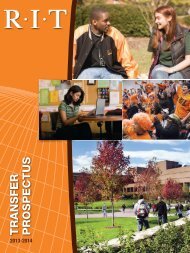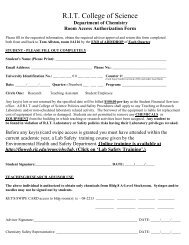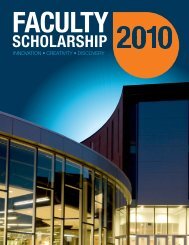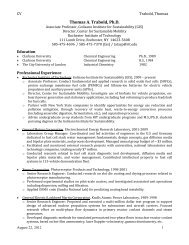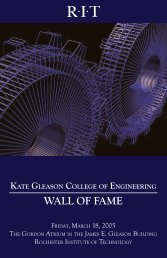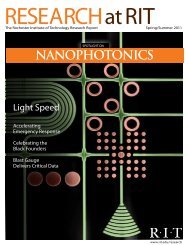Fall / Winter 2012 - Rochester Institute of Technology
Fall / Winter 2012 - Rochester Institute of Technology
Fall / Winter 2012 - Rochester Institute of Technology
You also want an ePaper? Increase the reach of your titles
YUMPU automatically turns print PDFs into web optimized ePapers that Google loves.
Focus Area | Unlocking the Mysteries <strong>of</strong> the Deaf Brain<br />
Unlocking the<br />
Mysteries <strong>of</strong> the Deaf Brain<br />
by Greg Livadas<br />
Although studied for centuries, much remains unknown about the human brain.<br />
The deaf brain in particular is still a mystery in part because this population<br />
<strong>of</strong>ten uses different cognitive and communication processes than hearing<br />
people. RIT’s Peter Hauser is a leader in analyzing the deaf brain, how it differs<br />
from the hearing brain, and the effect <strong>of</strong> sign language on cognition.<br />
The Deaf Brain vs. The Hearing Brain<br />
Hauser, a deaf clinical neuropsychologist and associate<br />
pr<strong>of</strong>essor in the American Sign Language and Interpreting<br />
Education Department at NTID, is investigating how the<br />
brain adapts and takes on different functions based on new<br />
parameters. In other words, how does deafness itself change<br />
how the brain operates?<br />
“We really understand so little about the human brain,”<br />
Hauser says. “Through my research I am seeking to uncover<br />
which cognitive processes are hard-wired, which are plastic,<br />
and how deafness or sign language may impact them.”<br />
Hauser argues the difference between deaf and hearing<br />
brains can have significant clinical impacts that can affect<br />
diagnosis and treatment <strong>of</strong> numerous diseases.<br />
“Suppose a deaf person has a stroke, which impacts his or<br />
her communication functions,” Hauser adds. “Because deaf<br />
people communicate differently and use different parts <strong>of</strong> the<br />
brain in that process, you can’t assume he or she will have the<br />
same symptoms or respond to the same therapies as a person<br />
who is hearing.”<br />
Analyzing the Cognitive Process<br />
“Peter is regarded nationally as one <strong>of</strong> the foremost experts<br />
in studies comparing deaf and hearing people’s brains and<br />
function,” says Daphne Bavelier, a pr<strong>of</strong>essor <strong>of</strong> brain and<br />
cognitive sciences at the University <strong>of</strong> <strong>Rochester</strong> who has<br />
collaborated with Hauser for close to a decade. “In particular,<br />
he is leading the way in characterizing how growing up deaf<br />
or hard <strong>of</strong> hearing impacts executive functions—a set <strong>of</strong> skills<br />
that is central to academic achievements.”<br />
Much <strong>of</strong> the previous clinical research involving deaf<br />
individuals focused on restoring hearing or adjusting learning<br />
style to mirror hearing peers. Instead, Hauser focuses on deaf<br />
individuals themselves, how they learn, how they think, and<br />
how deaf brains process and use information.<br />
Through partnerships with Gallaudet University’s NSF<br />
Science <strong>of</strong> Learning Center on Visual Language and Visual<br />
Learning (VL2) and the University <strong>of</strong> <strong>Rochester</strong>’s Brain<br />
and Vision Laboratory, he has developed comprehensive<br />
Testing Cognition: Hauser’s team has developed a series <strong>of</strong> tests to<br />
assess the differences in how deaf and hearing people gain knowledge<br />
and process information. Data has been gathered from test subjects all<br />
over the world in multiple written and sign languages. More than 1,000<br />
people participated in this testing so far.<br />
Analyzing Visual Attention: Visual attention is the cognitive process by<br />
which a person selectively concentrates on an object or scene while<br />
ignoring other things and is a key component <strong>of</strong> learning. To analyze<br />
differences in attention between the deaf and hearing, participants were<br />
asked to discriminate a briefly presented face in the center <strong>of</strong> the display<br />
and to indicate the location <strong>of</strong> a peripheral target (a five-pointed star in a<br />
circle) via a touch screen.<br />
Research at RIT<br />
9





